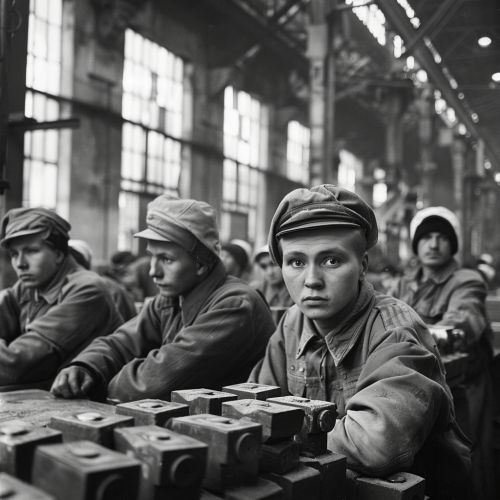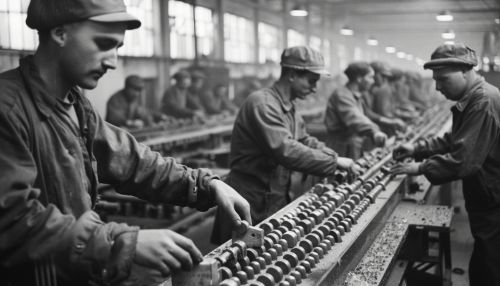Industrialization in the Soviet Union
Introduction
Industrialization in the Soviet Union was a pivotal period in the history of the country, marked by rapid economic transformation and significant social changes. This era, primarily spanning from the late 1920s to the early 1940s, was characterized by the implementation of ambitious Five-Year Plans aimed at transforming the Soviet Union from a predominantly agrarian society into a major industrial power. The process of industrialization in the Soviet Union was driven by the state's centralized planning and control over the economy, which had profound impacts on various aspects of Soviet life.
Historical Context
The industrialization of the Soviet Union began in earnest after the Russian Revolution of 1917 and the subsequent Russian Civil War. The Bolshevik government, led by Vladimir Lenin, initially focused on consolidating power and stabilizing the economy through the New Economic Policy (NEP), which allowed for a limited degree of private enterprise. However, by the late 1920s, under the leadership of Joseph Stalin, the Soviet government shifted towards a more radical approach to economic development.
The First Five-Year Plan (1928-1932)
The First Five-Year Plan, launched in 1928, was the Soviet Union's first major attempt at rapid industrialization. The plan aimed to increase the production of heavy industry, such as steel, coal, and machinery, while also improving infrastructure and transportation networks. The state directed massive investments into industrial projects, often at the expense of consumer goods and agriculture.


Objectives and Implementation
The primary objectives of the First Five-Year Plan were to:
- Increase industrial output by 250%.
- Boost agricultural production by 150%.
- Expand the workforce in industrial sectors.
The implementation of the plan involved the construction of new factories, the expansion of existing industrial facilities, and the development of new industrial regions, such as the Magnitogorsk steel plant. The state mobilized resources and labor, often through coercive measures, to achieve these ambitious targets.
Challenges and Outcomes
The First Five-Year Plan faced numerous challenges, including shortages of skilled labor, inadequate infrastructure, and logistical difficulties. Despite these obstacles, the plan resulted in significant increases in industrial output, particularly in heavy industry. However, the rapid pace of industrialization also led to severe social and economic disruptions, including widespread shortages of consumer goods and declining living standards for many Soviet citizens.
The Second Five-Year Plan (1933-1937)
Building on the achievements of the First Five-Year Plan, the Second Five-Year Plan aimed to further expand industrial production and improve the efficiency of the Soviet economy. This plan placed a greater emphasis on the development of the chemical industry, transportation, and communications.
Key Developments
During the Second Five-Year Plan, the Soviet government continued to prioritize heavy industry, but also sought to address some of the imbalances created by the first plan. Key developments included:
- Expansion of the Dnieper Hydroelectric Station, one of the largest hydroelectric power plants in the world at the time.
- Growth of the automobile industry, with the establishment of new factories such as the GAZ plant in Nizhny Novgorod.
- Improvements in the railway network to facilitate the transportation of raw materials and finished goods.
Social and Economic Impact
The Second Five-Year Plan led to further increases in industrial output and improvements in infrastructure. However, the focus on heavy industry continued to strain the agricultural sector and consumer goods production. The plan also saw the intensification of state control over the economy and society, with increased use of forced labor, particularly in the Gulag system.
The Third Five-Year Plan (1938-1941)
The Third Five-Year Plan was launched in 1938, with the goal of preparing the Soviet economy for potential military conflict. This plan placed a strong emphasis on the production of military equipment and the development of industries critical to national defense.
Military Industrialization
Key aspects of the Third Five-Year Plan included:
- Expansion of the armaments industry, with increased production of tanks, aircraft, and other military hardware.
- Development of new industrial centers in the Ural Mountains and Siberia to reduce vulnerability to potential invasions.
- Strengthening of the Soviet Air Force and Red Army through increased production of military vehicles and equipment.
Impact of World War II
The outbreak of World War II in 1939 had a profound impact on the Third Five-Year Plan. The Soviet Union was forced to redirect resources and labor towards the war effort, leading to disruptions in industrial production. Despite these challenges, the industrial base established during the previous plans played a crucial role in the Soviet Union's ability to withstand and eventually repel the Nazi invasion.
Social and Cultural Changes
The industrialization of the Soviet Union brought about significant social and cultural changes. The rapid growth of industrial cities led to urbanization and the migration of millions of people from rural areas to urban centers. This shift had profound effects on Soviet society, including changes in family structures, living conditions, and social norms.
Urbanization and Migration
The construction of new industrial cities, such as Magnitogorsk and Komsomolsk-on-Amur, attracted large numbers of workers from the countryside. This migration led to the growth of urban populations and the development of new social dynamics. The state also promoted the establishment of communal living arrangements, such as communal apartments, to address housing shortages.
Education and Workforce Development
The Soviet government placed a strong emphasis on education and workforce development to support industrialization. Technical schools and universities were established to train skilled workers and engineers. The state also implemented policies to promote literacy and basic education among the general population.
Cultural Propaganda
Industrialization was accompanied by extensive cultural propaganda aimed at promoting the values of socialism and the achievements of the Soviet state. The government used various forms of media, including newspapers, films, and posters, to glorify industrial labor and the contributions of workers. Cultural institutions, such as the Union of Soviet Writers, were mobilized to support the state's industrialization efforts.
Economic and Environmental Consequences
The industrialization of the Soviet Union had far-reaching economic and environmental consequences. While the rapid growth of heavy industry contributed to the country's economic development, it also led to significant environmental degradation and resource depletion.
Economic Growth and Challenges
The Soviet Union's industrialization resulted in substantial economic growth, particularly in the production of steel, coal, and machinery. However, the focus on heavy industry often came at the expense of other sectors, leading to imbalances in the economy. The state's centralized planning system also faced challenges in efficiently allocating resources and responding to changing economic conditions.
Environmental Impact
The rapid pace of industrialization had severe environmental consequences, including:
- Pollution of air and water due to industrial emissions and waste.
- Deforestation and soil degradation resulting from the expansion of industrial activities.
- Depletion of natural resources, such as coal and minerals, due to intensive extraction.
The environmental impact of industrialization was often overlooked by the Soviet government, which prioritized economic growth and industrial output over environmental protection.
Legacy of Industrialization
The industrialization of the Soviet Union left a lasting legacy on the country's economy, society, and environment. The industrial base established during this period played a crucial role in the Soviet Union's ability to compete on the global stage and withstand external threats. However, the social and environmental costs of industrialization also had long-term implications for the country's development.
Post-War Industrialization
The industrialization efforts continued after World War II, with the Soviet government launching new Five-Year Plans to rebuild and expand the economy. The post-war period saw further growth in industrial production, particularly in the fields of aerospace, nuclear energy, and electronics.
Impact on Soviet Society
The industrialization of the Soviet Union had a profound impact on Soviet society, shaping the country's social structures, cultural norms, and political dynamics. The state's emphasis on industrial labor and collective effort influenced the development of Soviet identity and the values of the Soviet people.
Environmental Legacy
The environmental consequences of industrialization continued to be felt long after the initial period of rapid growth. Issues such as pollution, resource depletion, and environmental degradation remained significant challenges for the Soviet Union and its successor states.
See Also
- Five-Year Plans
- New Economic Policy
- Gulag
- Magnitogorsk
- Dnieper Hydroelectric Station
- Soviet Air Force
- Union of Soviet Writers
- Soviet people
